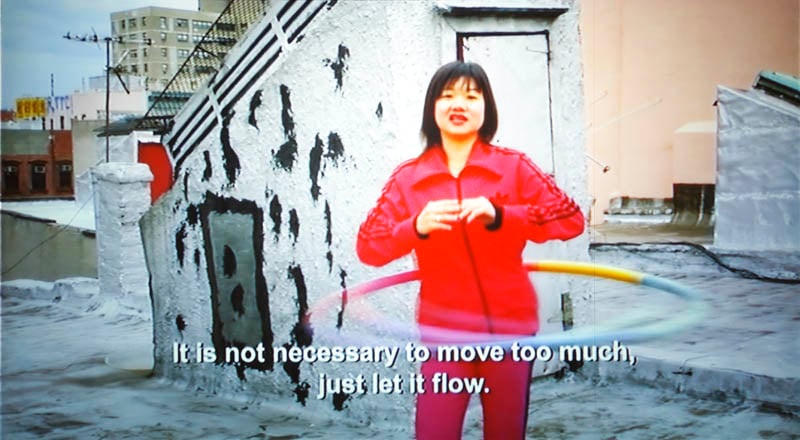
© » KADIST
Christian Jankowski
In New York City’s Chinatown, subject Suat Ling Chua’s morning exercise is to practice the hula hoop. When Christian Jankowski first saw this woman he immediately got the idea to shoot Rooftop Routine . In the short video, Chua leads the group and dictates the movements that each participant has to repeat.
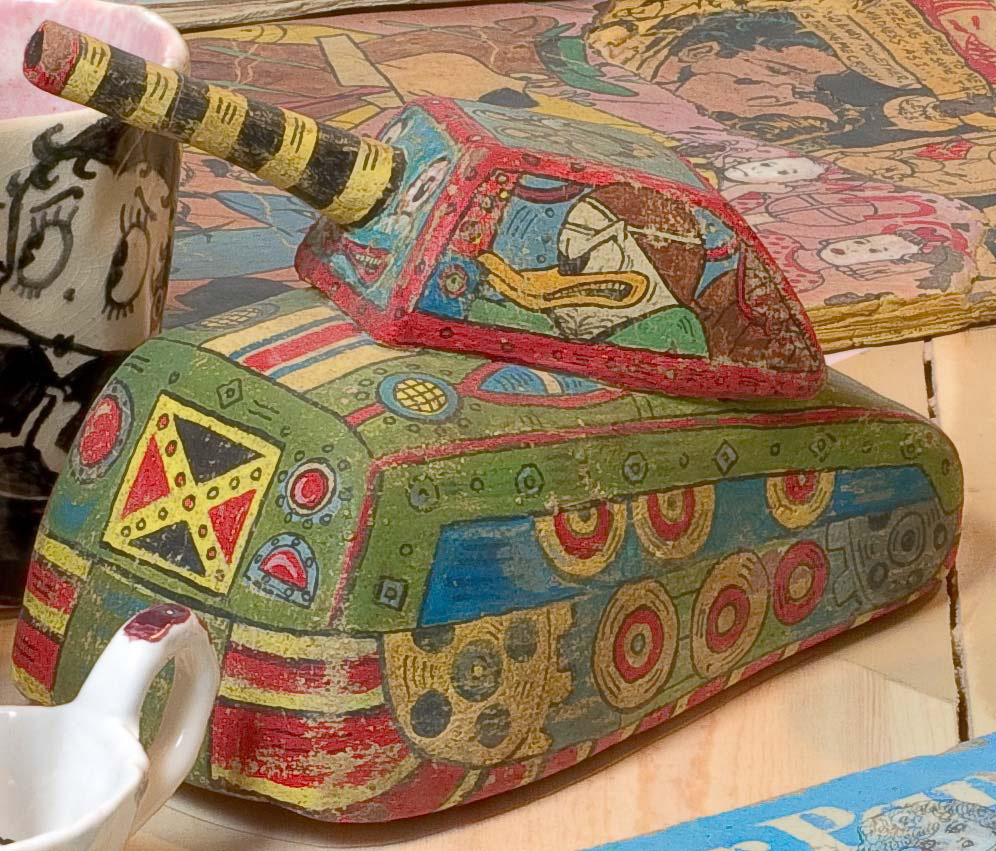
© » KADIST
Kristen Morgin
Donald of Doom Tank (2008) is a replica of a vintage metal toy with Donald Duck’s image one side and a soldier on the other. During World War II, the Walt Disney Company produced series of cartoon shorts that featured Donald Duck’s nightmare of working in an inhumane artillery factory in Nazi Germany and serving in the U. S. Army. By animating and normalizing war and military life, these cartoons not only achieved widespread popularity, but functioned as government propaganda.

© » KADIST
Kristen Morgin
Jeep Comics is based on the second of only two issues published by RB Leffingwell and Company in 1944–45. Though largely unknown, their protagonists, Jeep and Peep, embody the ethos of “Golden Age” comic books in which magically empowered heroes triumph over evils to boost patriotic enthusiasm.

© » KADIST
Lu Chunsheng
Lu has developed an oeuvre that consists of characters in bizarre situations. The large-scale photograph I Want to Be a Gentleman depicts nine men standing like statues on display in a museum on tall plinths in front of a run-down industrial building. Lu’s brooding films and photographs are preoccupied with China’s industrial era and communist history.

© » KADIST
Doug Aitken
The version of Frontier acquired by the Kadist Collection consists of a single-channel video, adapted from the monumental installation and performance that Aitken presented in Rome, by the Tiber River, in 2009. In this film, Aiken’s allusion to “the frontier” and iconic imagery like the cowboy suggest that the American West Coast as a cultural construction. These notions are reinforced by two key elements in the film: its protagonist, the iconic West Coast artist Ed Ruscha, and its reference to the cinematic and the experience of the movie theater.

© » KADIST
Yang Zhenzhong
Peasant Sensation Passing Through Flesh – 3 consists of a massage chair fixed to a wall. With its cushions removed to reveal its internal mechanisms, the chair’s programmed rubbing, kneading, patting, and vibrating motions create a strange sight and soundscape. The work explores the relationship between flesh and machine as they come together through technologically simulated social behaviors, challenging normative ideas about human interaction.

© » KADIST
Minouk Lim
New Town Ghost (2005) is one of Lim’s trio of large-scale video installations. (The other two are S. O. S—Adoptive Dissensus [2009] and The Weight of Hands [2010].) The series grew out of her interest in capturing lost memories and the collective unconscious in rapidly globalizing cities such as Seoul.

© » KADIST
Jun Nguyen-Hatsushiba
Filmed underwater, this is the third video in Nguyen-Hatsushiba’s “Memorial Project” series which began in 2001. The title already implies the cultural complexities about to be ironically unravelled: Ho Chi Minh is parodied and Okinawa (where this was filmed) was a battle site in Japan during World War II which then became an American training base during the Vietnam War. To a remix of James Bond movie tracks composed by Quoc Bao, no less than thirty divers in wet suits and full gear advance against the water resistance armed with cartridges of color.

© » KADIST
Mark Grotjahn
Drawing & Print (Drawing & Print)
This particular drawing, like many of Grotjahn’s works, presents a decentered single-point perspective. Unlike the traditional vanishing point, the rays here emanate from the surface’s middle and hover around an indefinite and impossible convergence. The resulting fluttering of the image’s sections animates the drawing in relationship to its named subject, the butterfly.

© » KADIST
Wolfgang Tillmans
Wolfgang Tillmans initiated the ongoing series Faltenwurf in 1989, representing compositions of unused clothing, with special attention paid to the ways in which they drape and fold. The title is taken from a Germanic term used in the context of art history, designating classical drapery. In this particular photograph, Faltenwurf (Stairwell) , an assortment of various colored clothes lay tangled on a set of stairs, as a sculpture of abstract forms.

© » KADIST
Martin Creed
This photograph of Martin Creed himself was used as the invitation card for a fundraising auction of works on paper at Christie’s South Kensington in support of Camden Arts Centre’s first year in a refurbished building in 2005. His broad smile, on the verge of laughter, encourages reciprocity on behalf of the onlooker. This could be said to be a typical tactic in Creed’s work as it is so infused with humor and irony.

© » KADIST
Shaun O'Dell
The San Francisco–based artist Shaun O’Dell often uses natural settings as subject matter, lending an artistic complexity to the landscapes he depicts. Stereoscopic images are dual, slightly offset identical pictures that, when seen through a special viewing device, appear three-dimensional. In Temple Creek, a branch of Escalante River, Aquarius Plateau Utah n.d. (Stereoscopic view) (2011) O’Dell has chopped each of the two side-by-side images into 10 vertical strips and mixed them up, to construct a new image.

© » KADIST
Chris Johanson
Chris Johanson’s paintings, sculptures, and installations break down everyday scenes and commonplace dramas into colorful forms; the darkest sides of humanity are invoked with humor. The works comment on subjects such as capitalism, consumerism, the art world, and therapy. The triptych I Am a Human, Abstract Foil, No Humans IV (2004) is a meditation on the cosmos.

© » KADIST
Shaun O'Dell
Shaun O’Dell’s paintings, installations, videos, sculptures, and music explore the overlapping realities of human and natural structures. Whether abstract or figurative, they often read like hieroglyphics, in that they piece together a philosophical portrait of reality. Purple Brush 8 is a painting that details a meeting of geometric forms, and the optical play that results.

© » KADIST
Chris Johanson
Apartment on Cardboard (2000) is an exterior view of an abstracted apartment building. Viewers unwittingly become voyeurs, peering through the rectangles that stand for windows and observing the residents therein, who ponder questions both mundane and existential: “Where is Ron now?” and “What have I become?” The queries and characters are treated democratically—not judged, praised, or subjected to hierarchy. While their thoughts are specific, the painting captures a universal urban activity: looking across to the building next door and wondering about its residents, all the while knowing that they have probably looked over and wondered about us, as well.
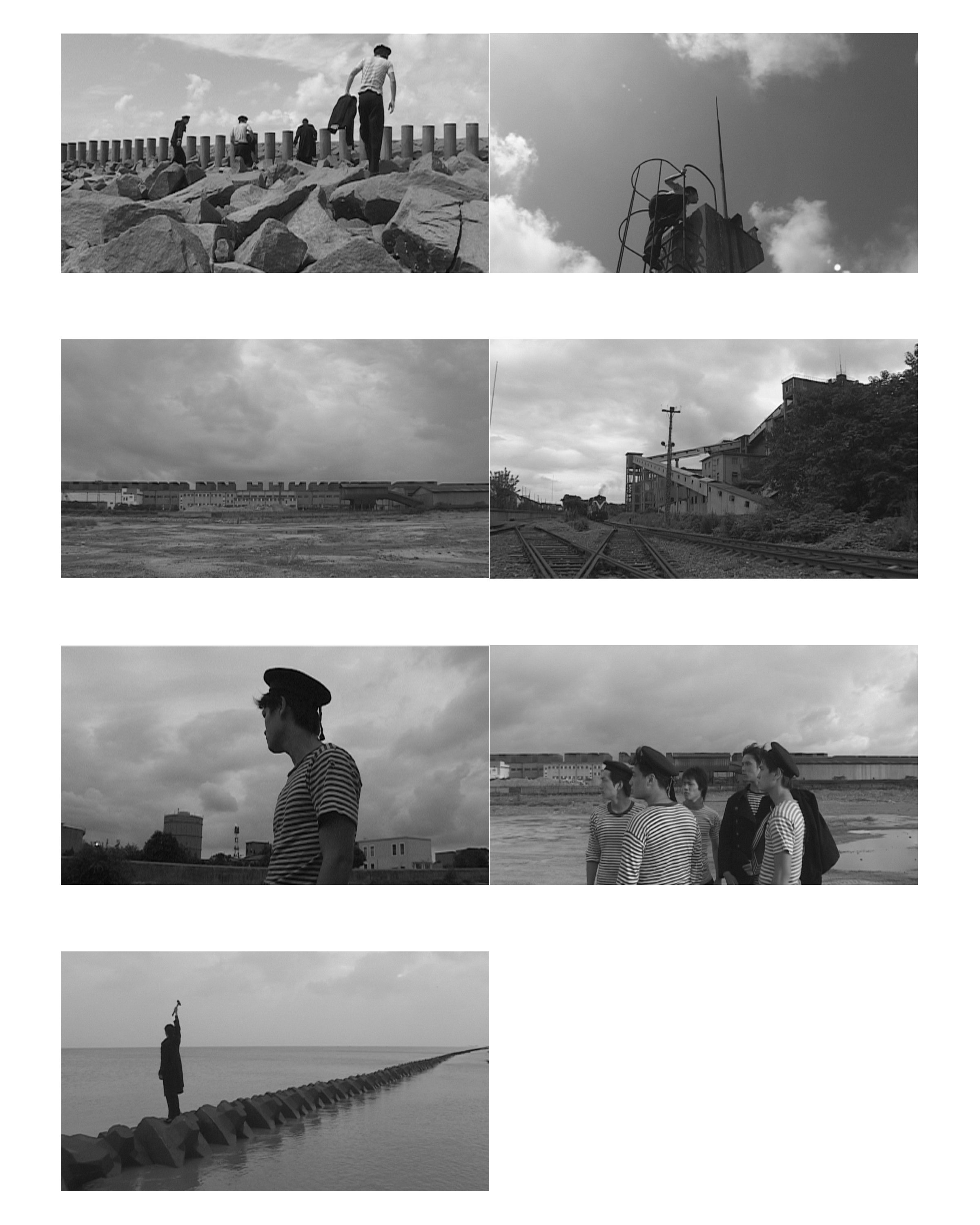
© » KADIST
Lu Chunsheng
A mesmerizing experience of a vaguely familiar yet remote world, History of Chemistry I follows a group of men as they wander from somewhere beyond the edge of the sea through a vast landscape to an abandoned steel factory. Using long shots and atypical settings, Lu Chunsheng enigmatically refers to a distant history while conveying the sense of dislocation wrought by successive stages of modernization. The combination of elaborate landscape shots from the suburbs of Shanghai and Lu’s signature style of spare and minimally crafted acting offers a surreal view of human behavior in spaces marked by the hulking remnants of China’s extraordinary development.

© » KADIST
Dinh Q. Lê
Hill of Poisonous Trees (three men) (2008) exemplifies the artist’s signature photo-weaving technique, in which he collects diverse found photographs—portraits of anonymous people, stills from blockbuster films, or journalistic images—cuts them into strips, and weaves them into new composition. The title of the series is translated from the Khmer phrase Tuol Sleng , which literally means a poisonous hill or a place on a mound to keep those who bear or supply guilt, and the photographs came from the Tuol Sleng Genocide Museum in Cambodia, a former prison where at least 200,000 Cambodians were executed during the reign of the Khmer Rouge between 1975 and 1979. In this particular image, three men stand against the backdrop of what looks like a prison interior.

© » KADIST
Todd Hido
The two pieces in the Kadist Collection depict foggy landscapes, one at dawn, the other at nighttime. Both dimly lit scenes are dominated by an eerie feeling. Taken by a road, these painterly photographs suggest the uncanny character of the transient.
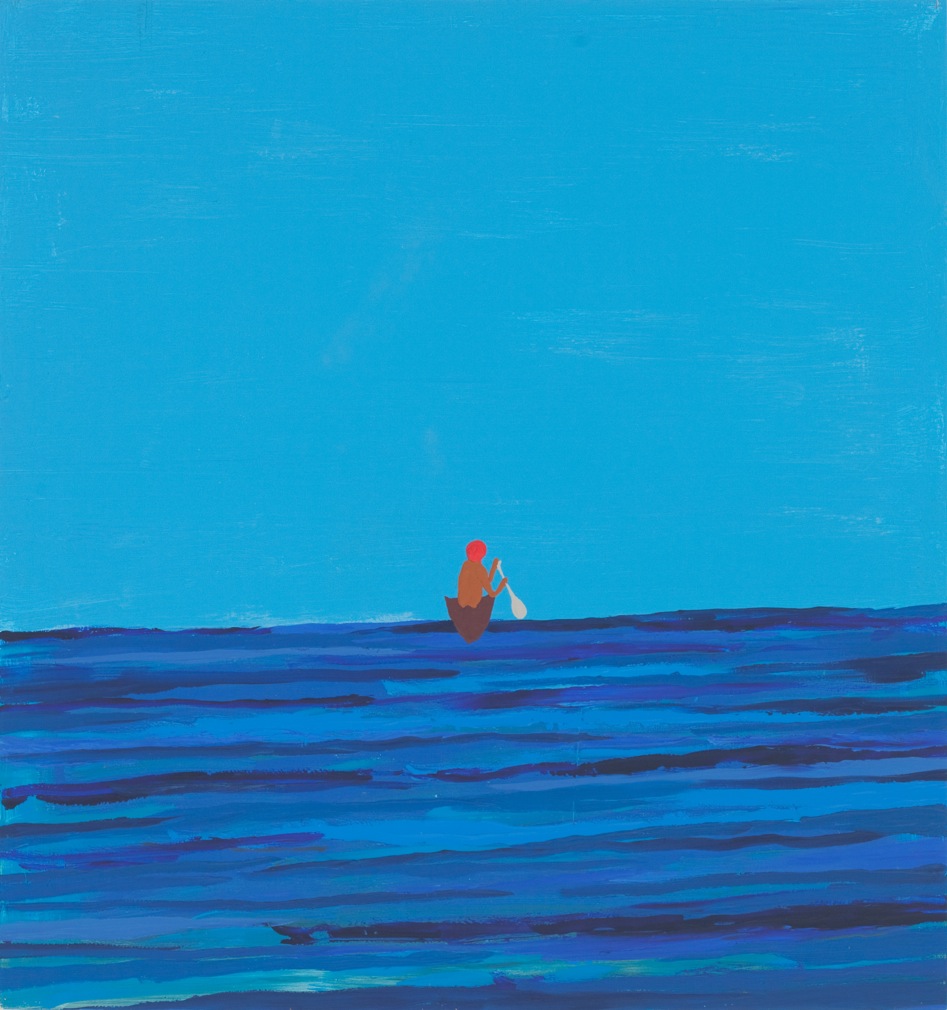
© » KADIST
Chris Johanson
Chris Johanson’s Untitled (Painting of a Man Leaving in Boat) (2010) pictures a canoe drifting toward an off-kilter horizon line, which demarcates the cobalt sea from the cerulean sky. An orange-haired figure, oar positioned in mid-stroke, looks ahead—whether toward an edge or an infinite expanse, it is impossible to tell. Echoing a trope that recurs in Greek epic poetry, transcendental painting, and current-day reality television, the character is alone with nature.

© » KADIST
Abraham Cruzvillegas
Wright Imperial Hotel (2004) is a sort of bow and arrow made out of feathers, a São Paulo phone book, and other materials. The title is a reference to a building Frank Lloyd Wright designed for Tokyo, which was completed in 1923. In its heyday, which lasted until after World War II, the hotel was reserved for elite personnel, many of them foreigners.
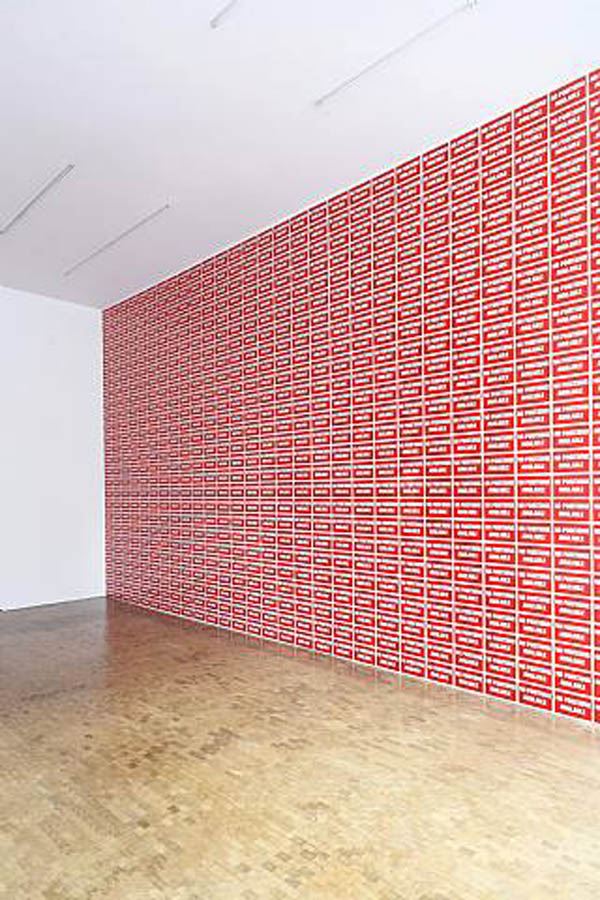
© » KADIST
Ceal Floyer
NO POSITIONS AVAILABLE is composed of panels covering the entire wall of the gallery exemplifying one of the tendencies of the artist. The “billboard sign,” like a ready-made, plays with the different meanings of the title, literally and abstractly. The repetition of the sign, as it has used in Minimal and Conceptual art, fills the space.

© » KADIST
Minouk Lim
The Possibility of the Half by Minouk Lim is a two-channel video projection that begins with a mirror image of a weeping woman kneeling on the ground. As both frames progresses, a montage of large crowds of mourners are depicted in slow motion interwoven with a variety of images including bomb explosions, fireworks, vacant stores, sunsets and sunrises, beachside landscapes, and infrared shots. At midpoint, life in the year 4012 is foreshadowed down to living insects and the video concludes back in the year 2012 as a burning inferno.
Martin Creed
- location: Wakefield, United Kingdom
- year born: 1968
- gender: male
- nationality: British
Chris Johanson
- location: Los Angeles, California
- year born: 1968
- gender: male
- nationality: American
- home town: San Jose, California
Minouk Lim
- location: Seoul, South Korea
- year born: 1968
- gender: female
- nationality: Korean
Mark Grotjahn
- location: Los Angeles, California
- year born: 1968
- gender: male
- nationality: American
- home town: Pasadena, California
Abraham Cruzvillegas
- location: Mexico
- year born: 1968
- gender: male
- nationality: Mexican
- home town: Mexico City, Mexico
Lu Chunsheng
- location: Shanghai, China
- year born: 1968
- gender: male
- nationality: Chinese
- home town: Changchun, Jilin province, China
Yang Zhenzhong
- location: Shanghai, China
- year born: 1968
- gender: male
- nationality: Chinese
- home town: Xiaoshan, China
Ceal Floyer
- location: Karachi, Pakistan
- year born: 1968
- gender: female
- nationality: Pakistani
Christian Jankowski
- location: Göttingen, Deutschland
- year born: 1968
- gender: male
- nationality: German
Doug Aitken
- year born: 1968
- gender: male
- nationality: American
- home town: Redondo Beach, California
Wolfgang Tillmans
- location: London & Berlin
- year born: 1968
- gender: male
- nationality: German
- home town: Remscheid, Germany
Jun Nguyen-Hatsushiba
- location: Vietnam
- year born: 1968
- gender: male
- nationality: Japanese-Vietnamese
- home town: Tokyo, Japan
Todd Hido
- location: San Francisco, California
- year born: 1968
- gender: male
- nationality: American
- home town: Kent, Ohio
Chris Ofili
- location: Manchester, United Kingdom
- year born: 1968
- gender: male
- nationality: British
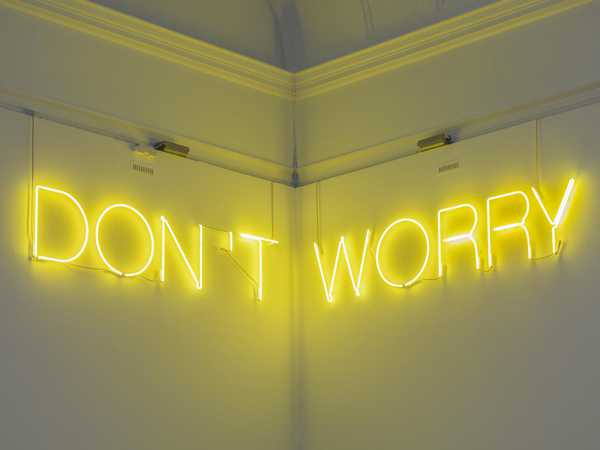
© » TATE EXHIBITIONS
about 3 months ago (01/06/2024)
Martin Creed | The Dick Institute Experience the work of one of this country’s most ingenious, audacious and surprising artists at the Dick Institute ARTIST ROOMS Martin Creed presents highlights from the British artist’s thirty-year career...
-
2000-2009
Chris Johanson
2000Apartment on Cardboard (2000) is an exterior view of an abstracted apartment building...
Mark Grotjahn
Drawing & Print
2002(Drawing & Print) This particular drawing, like many of Grotjahn’s works, presents a decentered single-point perspective...
Jun Nguyen-Hatsushiba
2003Filmed underwater, this is the third video in Nguyen-Hatsushiba’s “Memorial Project” series which began in 2001...
Martin Creed
2003This photograph of Martin Creed himself was used as the invitation card for a fundraising auction of works on paper at Christie’s South Kensington in support of Camden Arts Centre’s first year in a refurbished building in 2005...
Chris Johanson
2004Chris Johanson’s paintings, sculptures, and installations break down everyday scenes and commonplace dramas into colorful forms; the darkest sides of humanity are invoked with humor...
Lu Chunsheng
2004A mesmerizing experience of a vaguely familiar yet remote world, History of Chemistry I follows a group of men as they wander from somewhere beyond the edge of the sea through a vast landscape to an abandoned steel factory...
Abraham Cruzvillegas
2004Wright Imperial Hotel (2004) is a sort of bow and arrow made out of feathers, a São Paulo phone book, and other materials...
Ceal Floyer
2007NO POSITIONS AVAILABLE is composed of panels covering the entire wall of the gallery exemplifying one of the tendencies of the artist...
Christian Jankowski
2008In New York City’s Chinatown, subject Suat Ling Chua’s morning exercise is to practice the hula hoop...
Kristen Morgin
2008Donald of Doom Tank (2008) is a replica of a vintage metal toy with Donald Duck’s image one side and a soldier on the other...
Kristen Morgin
2008Jeep Comics is based on the second of only two issues published by RB Leffingwell and Company in 1944–45...
Dinh Q. Lê
2008Hill of Poisonous Trees (three men) (2008) exemplifies the artist’s signature photo-weaving technique, in which he collects diverse found photographs—portraits of anonymous people, stills from blockbuster films, or journalistic images—cuts them into strips, and weaves them into new composition...
Doug Aitken
2009The version of Frontier acquired by the Kadist Collection consists of a single-channel video, adapted from the monumental installation and performance that Aitken presented in Rome, by the Tiber River, in 2009...
-
2010-2019
Chris Johanson
2010Chris Johanson’s Untitled (Painting of a Man Leaving in Boat) (2010) pictures a canoe drifting toward an off-kilter horizon line, which demarcates the cobalt sea from the cerulean sky...
Shaun O'Dell
2011The San Francisco–based artist Shaun O’Dell often uses natural settings as subject matter, lending an artistic complexity to the landscapes he depicts...
Shaun O'Dell
2011Shaun O’Dell’s paintings, installations, videos, sculptures, and music explore the overlapping realities of human and natural structures...
Yang Zhenzhong
2012Peasant Sensation Passing Through Flesh – 3 consists of a massage chair fixed to a wall...
Minouk Lim
2012The Possibility of the Half by Minouk Lim is a two-channel video projection that begins with a mirror image of a weeping woman kneeling on the ground...
Wolfgang Tillmans
2017Wolfgang Tillmans initiated the ongoing series Faltenwurf in 1989, representing compositions of unused clothing, with special attention paid to the ways in which they drape and fold...



